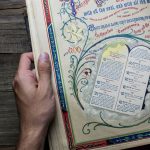Three of my grandchildren recently paid their annual summer visit to the sweltering Southeast. They brought their parents along as chaperones, which was nice enough.
Whenever two or three of my grandkids are gathered near me for more than 24 hours, I take the opportunity to do one of two things: practice and perform a play, or rev up “Dr. Pops’s Summer Bible School.” The oldest of the visiting grandkids turned 5 during her stay; her brothers are 2 and 9 months. They’re a bit young for King Lear, so Dr. Pops’s Summer Bible School it was.
Before they left, they knew the four faces of the cherubim (complete with hand motions), an outline of the creation account, the basic structures of creation, and a summary of the book of Genesis. Next time I’m with them, we’ll move into Exodus, and I’ll teach them how to offer each other as an animal sacrifice.
I’ve been teaching the Bible to small children—mostly my own—for more than 35 years, ever since my oldest son was a toddler. Over the years, I’ve learned a few tricks. Here are three.
1. Tell Bible Stories
God spoke to Israel in many portions and many ways (Heb. 1:1–3). He spoke law from Sinai, wisdom through kings, burning and shattering words through the prophets, and finally spoke himself in his Son, the Word. The order of the canon is the order of Israel’s, and humanity’s, maturation, as we grow up from childhood slavery to adult freedom (cf. Gal. 4), from priest to king to prophet to full stature in Christ.
It’s not an accident that the biblical history of maturation starts with a long book of stories. It’s where we begin. Before we learn to talk or walk or do abstract reasoning, we learned stories. Yahweh is the best parent. Before Israel received Torah, the tabernacle, the complexities of the sacrificial system, a land or a monarchy, they got stories, dramatic family stories.
God gave stories because he wanted us to read, tell and retell, live out of and into the stories themselves. Start there. Tell the stories. They’ll remember.
When my children were young, we had family worship most nights after dinner. I opened my Bible on my lap and retold a story. We started at Genesis and kept going until we got through the end of Acts, then we started over at Genesis and repeated the process. I can’t recall how many cycles we went through, but I repeated myself often because fresh kids kept showing up. As my children got older, we covered the rest of the New Testament, and we read passages together. At the start, though, I tried to get them hooked on the Bible by telling stories.
We’re tempted to skim past the stories to get to the moral kernel. We’re tempted to ignore details to abstract doctrinal content. Scripture teaches moral lessons, and the Bible’s stories have doctrinal import. We should teach all that to our children. But God gave stories because he wanted us to read, tell and retell, live out of and into the stories themselves.
So start there. Tell the stories. They’ll remember.
2. Show Them Jesus
During the 40 days between his resurrection and ascension, Jesus taught the Bible to his disciples (Luke 24). He taught two disciples on the road to Emmaus, and then the remaining 11. Luke tells us he taught the entire Old Testament—Moses, the prophets (former and latter), and the Psalms. He taught “everything concerning himself.” We know it from Jesus himself: the whole Bible is about him.
The Bible is a book of books, a grand story with lots of small stories in the middle. All the small stories are connected to the grand story, because all the small stories are part of the story of Jesus. The stories are pieces of a jigsaw puzzle. Once we’ve put the pieces together, as Irenaeus said, we discover a portrait of a glorious, beautiful King.
All the small stories are connected to the grand story, because all the small stories are part of the story of Jesus.
What kinds of pieces should we be looking for? Characters, for starters. Show them how Jesus is a better Adam because he resists the Devil in the wilderness, when Adam couldn’t fight the Devil in a garden. Show them that Jesus is attacked by his brothers, as Abel was by Cain and Joseph by his brothers. Show them how Samson conquered in the moment of his death, as Jesus did on the cross. When you look at Jeremiah, the weeping prophet, they’ll be reminded that Jesus wept.
Look for recurring events, too. At the beginning of Matthew’s Gospel, Jesus flees from a murderous king to the safety of Egypt, returns and grows up, is baptized in the Jordan, enters the wilderness to be tempted, and then teaches about the law on a mountaintop. He’s reliving the history of Israel again: slavery in Egypt, Pharaoh’s assault on Israelite babies, the exodus and wilderness, Sinai and the law. If you’re brave enough to slog through Leviticus, keep reminding them that Jesus offers the final, perfect sacrifice that brings us back to the Father.
The Bible doesn’t just connect everyone and everything to Jesus. It connects everyone and everything to everyone and everything else. Noah is a new Adam as well as a preview of Jesus. David fights like one of the judges, Hezekiah is a new David, and Jeremiah is like Moses.
I often said to my kids, “Wow! This is the first time in the Bible this has happened. This is the first time we’ve seen a character like this!” “Wow, this is the first time anyone has died of massive head trauma,” I said while telling the story of David and Goliath. “This is the first time anybody has drowned.” “This is the first time anyone has nearly died and come back to life.” “This is the first man to meet his wife at a well.” They knew it was a cue that meant the opposite. “No! Other people died from head wounds,” and they would rattle off Sisera and Abimelech, and remember the serpent’s crushed head. “Every man meets his wife at a well!”
Children are natural typologists, and only stop being typologists if we discourage them. They don’t know the word typology, but they know the game. Play it.
3. Sing the Bible
Some years ago, while serving as a pastor in Idaho, I led a summer Bible school for the elementary-aged children at church. I wrote a set of songs to help them learn the patterns of biblical theology. I was late in coming to recognize the power of singing, but now I wouldn’t try to teach children any other way. Singing or chanting makes the Bible visceral and rhythmic. It impresses the Bible into a child’s brain and body.
I tried to make the songs fun. I didn’t want to make them cute. I wanted the songs to set the grooves for reading and thinking about the Bible that would guide the children as they grew up. I didn’t want them to dismiss the Bible as a childish thing.
Do not underestimate what a child can learn about Scripture. They can learn more than we realize, and they can have fun doing it.
Let me give an example. The book of Genesis begins with three falls that culminate in the great de-creation of the flood. After the flood and Babel, the story focuses on three patriarchs, who begin to renew the world by reversing the three falls. The whole thing goes like this (bold syllables are emphasized):
Adam, Cain, and the sons of God (the three falls)
WHOOSH! (flood; make a sweeping flood-like hand motion)
Babel
Abraham, Jacob, Joseph (the three patriarchs)
Adam sins by disobeying Yahweh, while Abraham obeys even when it will cost him his son. Cain kills Abel; Jacob is an Abel who escapes his murderous brother Esau. The sons of God intermarry and corrupt the world; Joseph resists seduction and feeds the world.
One of the best Bible singers around is the Canadian songwriter Jamie Soles. In his many albums, he’ll get your kids singing the Bible ABCs, odd tales like the Benjamites who need wives, and repetitive passages like Numbers 7, which lists the same items again and again and again. There are others, but few sing the nitty-gritty of Scripture as well as Soles does.
Teach the Bible
Maybe this is the most important lesson: I learned early on not to underestimate what children can learn about Scripture. They can learn more than we realize, and they can have fun doing it.
I learned children respond readily to their Father’s voice, so long as I remembered to teach them the Bible instead of using the Bible to teach them something else.
Is there enough evidence for us to believe the Gospels?
 In an age of faith deconstruction and skepticism about the Bible’s authority, it’s common to hear claims that the Gospels are unreliable propaganda. And if the Gospels are shown to be historically unreliable, the whole foundation of Christianity begins to crumble.
In an age of faith deconstruction and skepticism about the Bible’s authority, it’s common to hear claims that the Gospels are unreliable propaganda. And if the Gospels are shown to be historically unreliable, the whole foundation of Christianity begins to crumble.



































